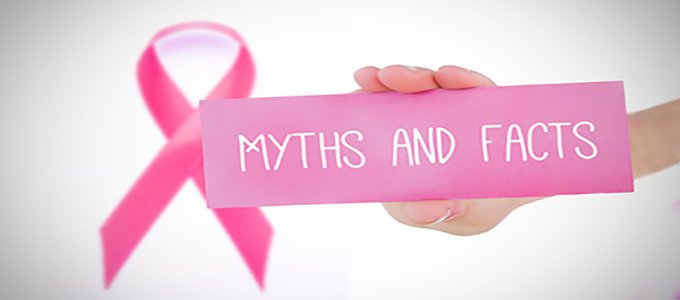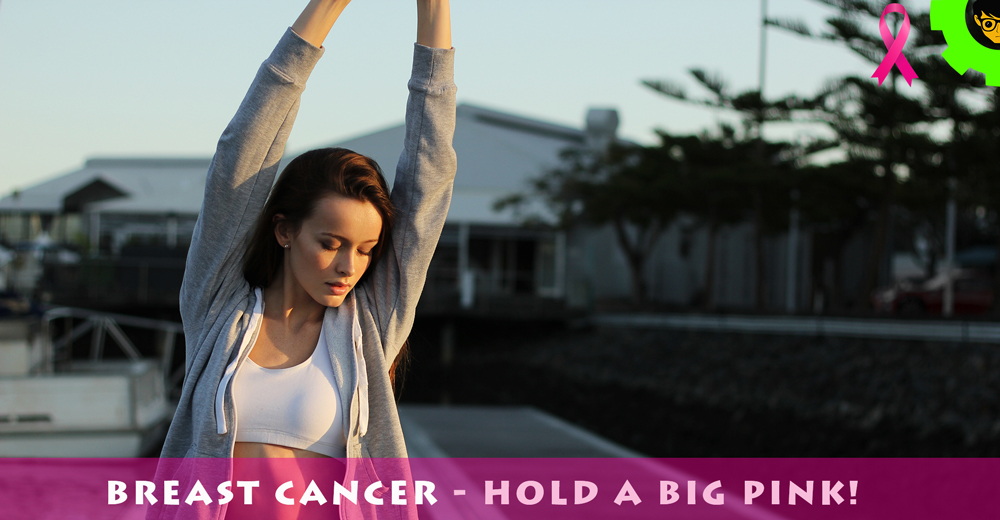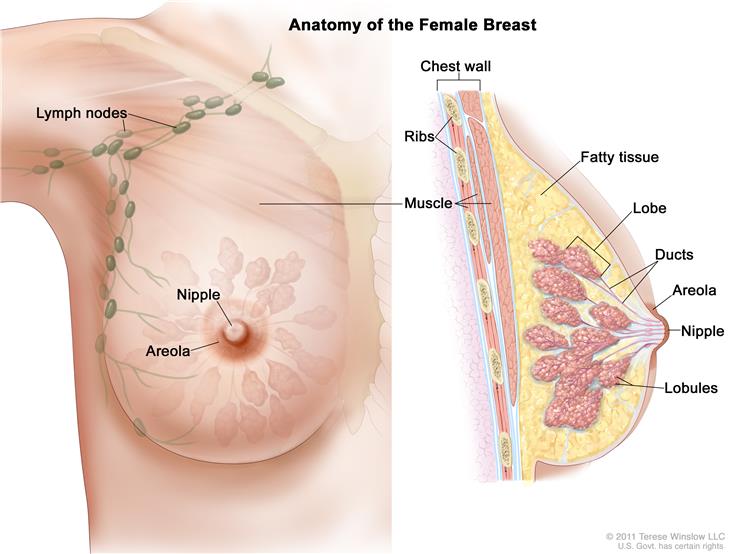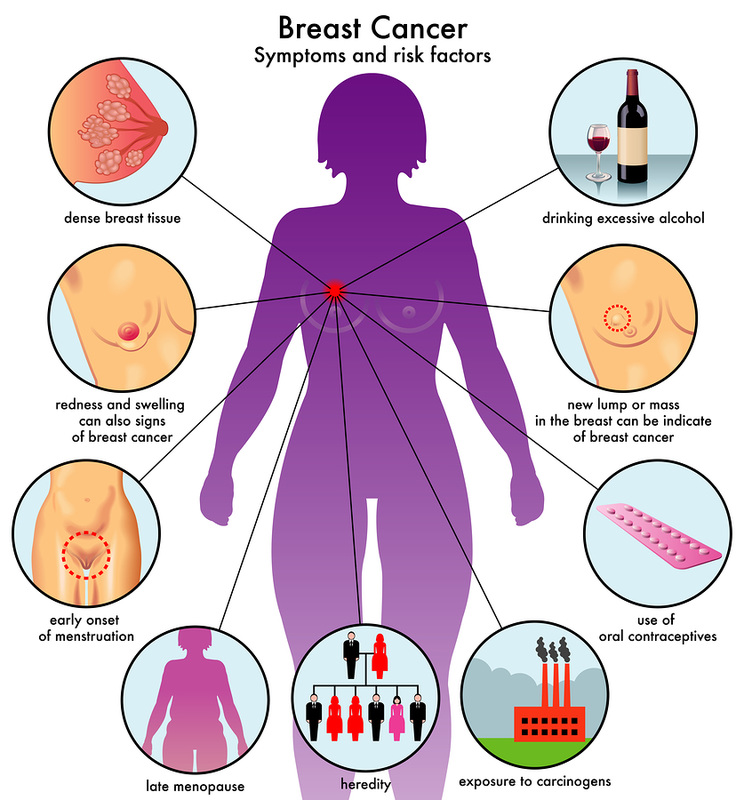Breast cancer is the most common cancer in women both in the developed and less developed world. It is estimated that worldwide over 508 000 women died in 2011 due to breast cancer (Global Health Estimates, WHO 2013).
Although breast cancer is thought to be a disease of the developed world, almost 50% of breast cancer cases and 58% of deaths occur in less developed countries (GLOBOCAN 2008).
Breast cancer is a disease in which malignant (cancer) cells form in the tissues of the breast.
Overview
The breast is made up of lobes and ducts. Each breast has 15 to 20 sections called lobes. Each lobe has many smaller sections called lobules. Lobules end in dozens of tiny bulbs that can make milk. The lobes, lobules and bulbs are linked by thin tubes called ducts.
Each breast also has blood vessels and lymph vessels. The lymph vessels carry almost colorless fluid called lymph. Lymph vessels carry lymph between lymph nodes. Lymph nodes are small bean-shaped structures that are found throughout the body. They filter substances in lymph and help fight infection and disease. Clusters of lymph nodes are found near the breast in the axilla (under the arm), above the collarbone and in the chest.Cancer occurs as a result of mutations or abnormal changes, in the genes responsible for regulating the growth of cells and keeping them healthy. The genes are in each cell’s nucleus, which acts as the “control room” of each cell. Normally, the cells in our bodies replace themselves through an orderly process of cell growth: healthy new cells take over as old ones die out. But over time, mutations can “turn on” certain genes and “turn off” others in a cell. That changed cell gains the ability to keep dividing without control or order, producing more cells just like it and forming a tumor.
A tumor can be benign (not dangerous to health) or malignant (has the potential to be dangerous). Benign tumors are not considered cancerous: their cells are close to normal in appearance, they grow slowly and they do not invade nearby tissues or spread to other parts of the body. Malignant tumors are cancerous. Left unchecked, malignant cells eventually can spread beyond the original tumor to other parts of the body.The term “breast cancer” refers to a malignant tumor that has developed from cells in the breast. Usually breast cancer either begins in the cells of the lobules, which are the milk-producing glands, or the ducts, the passages that drain milk from the lobules to the nipple. Less commonly, breast cancer can begin in the stromal tissues, which include the fatty and fibrous connective tissues of the breast too.Over time, cancer cells can invade nearby healthy breast tissue and make their way into the underarm lymph nodes, small organs that filter out foreign substances in the body. If cancer cells get into the lymph nodes, they then have a pathway into other parts of the body. The breast cancer’s stage refers to how far the cancer cells have spread beyond the original tumor.
Stages of Breast Cancer
Stage 0 (carcinoma in situ)
This is cancer that is confined to the lobules or ducts in the breast. It has not spread to surrounding tissue. Lobules are parts of the breast that produce milk. Ducts carry the milk to the nipple. Stage 0 cancer is called noninvasive. This means it has not spread. Some stage 0 cancers become invasive later. But doctors cannot tell which ones will and which will not. Stage 0 is also used to describe Paget disease. That is a rare type of breast cancer that just involves the nipple.
Stage I
The tumor is small (or may be too small to see) and invasive. It may or may not have spread to the lymph nodes close to the breast.
Stage II
There may be no tumor found in the breast, but cancer can be found that has spread to axillary lymph nodes or nodes close to the breastbone. Axillary nodes are nodes found in a chain from under the arm to above the collarbone. There might also be a tumor between 2 and 5 centimeters in the breast with small cancers in some of the lymph nodes. Or the tumor could be larger than 5 centimeters with no cancer in the nodes.
Stage IIIA
Cancer has spread to 4 to 9 axillary nodes or to nodes near the breastbone but not to other parts of the body. Or there could be a tumor larger than 5 centimeters and cancer that has spread to 3 axillary nodes or to nodes near the breastbone.
Stage IIIB
The tumor has spread to the chest wall or to the skin of the breast causing an ulcer or swelling. It may also have spread to axillary nodes but not to other parts of the body.
Stage IIIC
Cancer of any size has spread to at least 10 axillary nodes. It may also have spread to the skin of the breast or breast wall, but not to distant parts of the body.
Stage IV
The cancer is metastatic, which means it has spread to other organs such as the bones, lungs, brain, or liver.
Causes of Breast Cancer
Although the precise causes of breast cancer are unclear, we know the main risk factors. Still, most women considered at high risk for breast cancer do not get it, while many with no known risk factors do develop breast cancer. Among the most significant factors are advancing age and a family history of breast cancer. Risk increases for a woman who has certain types of benign breast lumps and increases significantly for a woman who has previously had cancer of the breast or the ovaries.A woman whose mother, sister, or daughter has had breast cancer is two to three times more likely to develop the disease, particularly if more than one first-degree relative has been affected. Researchers have identified two genes responsible for some instances of familial breast cancer. These genes are known as BRCA1 and BRCA2. About one woman in 200 carries the genes. Having one of them predisposes a woman to breast cancer but does not ensure that she will get it. Generally, women over age 50 are more likely to get breast cancer than younger women, and African-American women are more likely than Caucasians to get breast cancer before menopause.
A link between breast cancer and hormones is clear. Researchers think that the greater a woman’s exposure to the hormone estrogen, the more susceptible she is to breast cancer. Estrogen tells cells to divide; the more the cells divide, the more likely they are to be abnormal in some way, possibly becoming cancerous. A woman’s exposure to estrogen and progesterone rises and falls during her lifetime, influenced by the age she starts and stops menstruating, the average length of her menstrual cycle, and her age at first childbirth. A woman’s risk for breast cancer is increased if she starts menstruating before age 12, has her first child after age 30, stops menstruating after age 55, or has a menstrual cycle shorter or longer than the average 26-29 days. Current information indicates that the hormones in birth control pills probably do not significantly increase the risk. Some studies suggest that taking hormone replacement therapy after menopause may increase risk, especially when taken for more than five years. The jury is still somewhat out on this matter, though. Heavy doses of radiation therapy may also be a factor, but low-dose mammograms pose almost no risk.
Symptoms of Breast Cancer
Following unusual changes in the breast can be a symptom of breast cancer:
- Swelling of all or part of the breast
- kin irritation or dimpling
- Breast pain
- Nipple pain or the nipple turning inward
- Redness, scaliness, or thickening of the nipple or breast skin
- A nipple discharge other than breast milk
- A lump in the underarm area
Sometimes a breast cancer can spread to lymph nodes under the arm or around the collar bone and cause a lump or swelling there, even before the original tumor in the breast tissue is large enough to be felt. Swollen lymph nodes should also be reported to your doctor. Although any of these symptoms can be caused by things other than breast cancer, if you have them, they should be reported to your doctor so that he or she can find the cause. Because mammograms do not find every breast cancer, it is important for you to be aware of changes in your breasts and to know the signs and symptoms of breast cancer.
Treatments
Cancer treatment programmes
The main goals of a cancer diagnosis and treatment programme are to cure or considerably prolong the life of patients and to ensure the best possible quality of life to cancer survivors. The most effective and efficient treatment programmes are those that:
a) Provided in a sustained and equitable way
b) Linked to early detection
c) Adhere to evidence-based standards of care and a multidisciplinary approach Such programmes also ensure adequate therapy for cancer types that, although not amenable to early detection, have high potential for being cured (such as metastatic seminoma and acute lymphatic leukaemia in children), or have a good chance of prolonging survival in a significant way (such as breast cancer and advanced lymphomas).
Treatments for breast cancer
A multidisciplinary team will be involved in a breast cancer patient’s treatment. The team may consist of an oncologist, radiologist, specialist cancer surgeon, specialist nurse, pathologist, radiologist, radiographer and reconstructive surgeon. Sometimes the team may also include an occupational therapist, psychologist, dietitian, and physical therapist.
The team will take into account several factors when deciding on the best treatment for the patient, including:
- The type of breast cancer
- The stage and grade of the breast cancer – how large the tumor is, whether or not it has spread, and if so how far
- Whether or not the cancer cells are sensitive to hormones
- The patient’s overall health
- The age of the patient (has she been through the menopause?)
- The patient’s own preferences.
The main breast cancer treatment options may include:
- Radiation therapy
- Surgery
- Biological therapy (targeted drug therapy)
- Hormone therapy
- Chemotherapy
Major Breast Cancer Myths

Myth 1: An injury to the breast can cause cancer
An injury, such as falling or being hit in the chest, will not cause breast cancer. It may cause bruising and swelling to the breast, which can be tender or painful to touch. Sometimes an injury can lead to a benign (not cancer) lump known as fat necrosis. This is scar tissue that can form when the body naturally repairs the damaged fatty breast tissue.
Myth 2: Most breast cancer runs in the family
Most cases of breast cancer happen by chance and not because of a family history. Only around 5% of breast cancers are caused by inheriting an altered gene. Because breast cancer is one of the most common cancers in the world, it’s not unusual to have one or two people in an extended family who have had breast cancer. For most people, having a relative with breast cancer doesn’t increase their risk of developing the disease.
Myth 3: Using deodorants causes breast cancer
There’s no conclusive evidence that deodorants and antiperspirants cause breast cancer. Some people worry that deodorants and antiperspirants stop the body from sweating out toxins which then build up in the lymph glands under the armpit, causing breast cancer. However, our bodies have several ways of getting rid of toxins and, while sweating is one of them, it doesn’t involve the lymph glands. There’s also no conclusive evidence that ingredients in deodorants and antiperspirants – such as aluminium or chemicals called parabens – cause breast cancer.
Myth 4: Underwire bras cause cancer
Underwire bras don’t increase your risk of breast cancer. There have been some concerns that the wires in the cup of the bra may restrict the flow of lymph fluid in the breast causing toxins to build up in the area. However, once again there’s no reliable evidence to support this. If your bra is too tight or too small, the wires can dig into your breasts and cause discomfort, pain or swelling.
Myth 5: Men can’t get breast cancer because they don’t have breasts
Men can get breast cancer. Many people don’t think of men as having breasts. In fact both men and women have breast tissue, although men have much smaller amounts than women. Most men who get breast cancer are over 60, although younger men can be affected.
Myth 6: Stress causes breast cancer
There’s no conclusive evidence that stress increases the risk of developing breast cancer. When we’re under stress, our lifestyle behaviors may change. For example, we might overeat and drink more alcohol. Being overweight and drinking too much alcohol both increases the risk of developing breast cancer.
Myth 7: The first sign of breast cancer is always a lump
A lump is only one of several possible symptoms of breast cancer and not everyone with breast cancer has a noticeable lump. It’s important to look at and feel your breasts regularly. So you know what’s normal for you, and to tell your doctor as soon as possible if you notice any changes. Most breast changes are likely to be normal or due to a benign breast condition, but it’s still important to get them checked.
Myth 8: Drinking warm water from a plastic bottle causes cancer
Drinking warm bottled water doesn’t increase the risk of breast cancer. Some people worry that warming (or freezing) plastic bottles or food containers releases a chemical called bisphenol A (BPA) which can interact with our hormones and cause breast cancer. It’s true that if a plastic bottle or container is exposed to extremely high temperatures, chemicals such as BPA in the plastic are released into the water or food product inside. But the amount released would still be within safe limits and would not cause any harm.
Myth 9: Mobile phones cause breast cancer
Some people worry that radio waves produced and received by mobile phones may pose a health risk, especially if they keep their phone in their breast pocket. These radio waves are a type of low-energy, non-ionising radiation. This type of radiation also includes visible light, ultraviolet (UV) and infrared radiation. While it’s not possible to isolate any one factor as a cause of breast cancer, there’s currently no evidence that radio waves from mobile phones cause breast cancer or increase the risk of developing it.
Aside from the cancer treatments, we now know that adopting certain lifestyles can affect a woman’s chances of keeping cancer at bay. However, there are many tools available for treatment has grown tremendously over the past several decades and women with breast cancer today are certainly benefiting from those advances.



